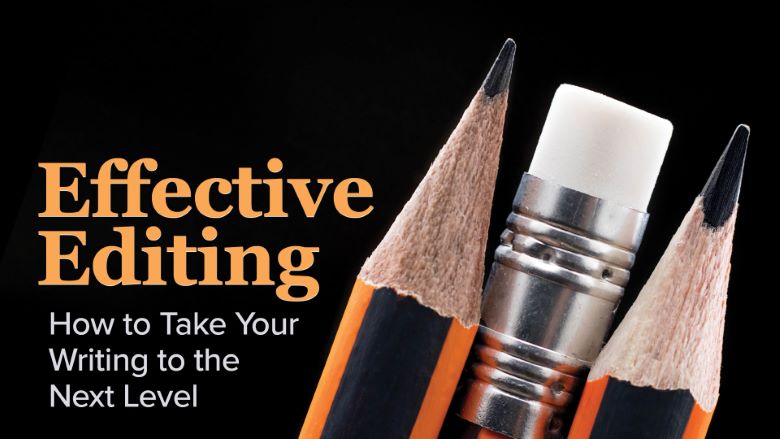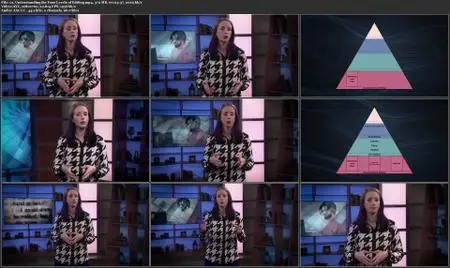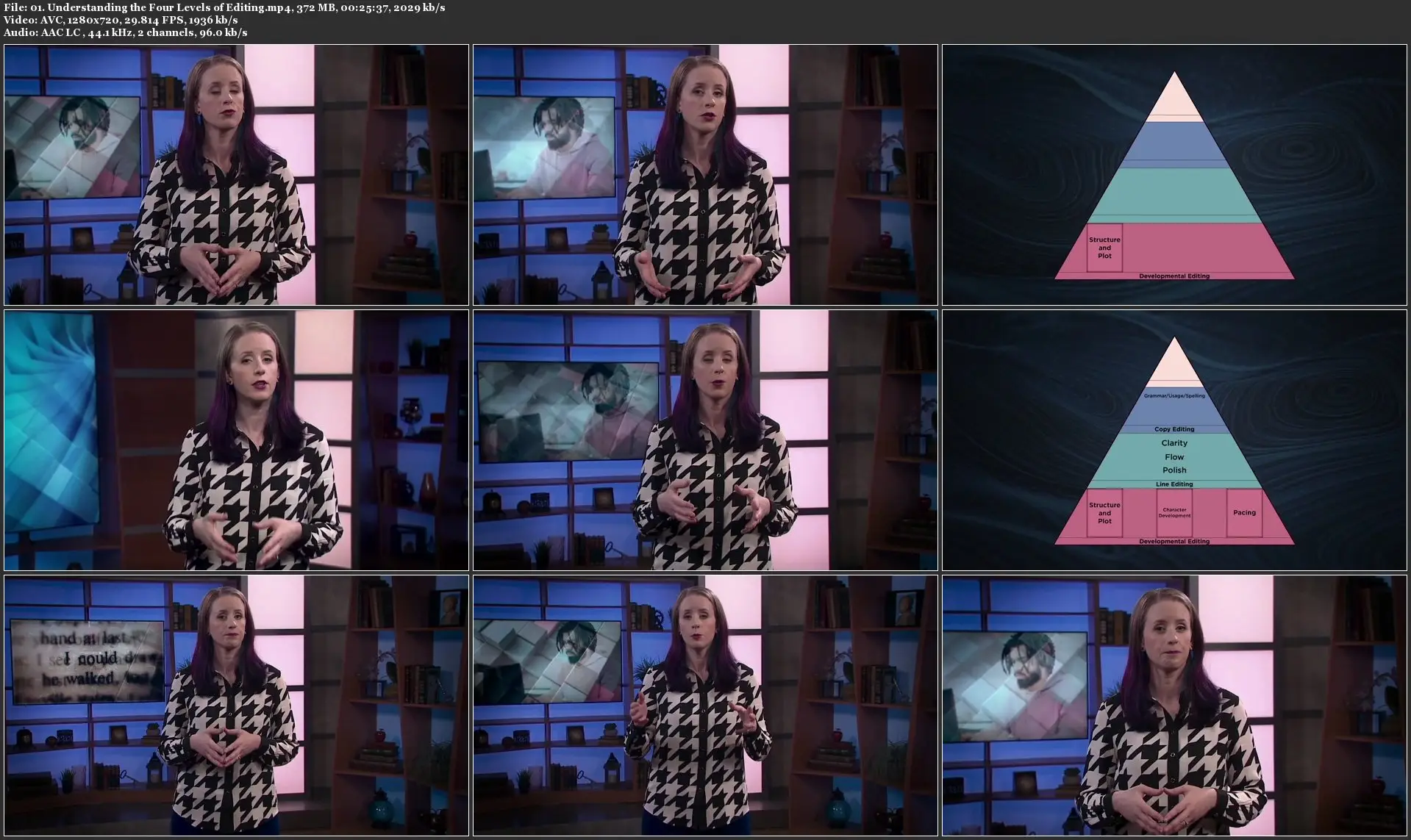TTC Video - Effective Editing: How to Take Your Writing to the Next Level
.MP4, AVC, 1280x720, 30 fps | English, AAC, 2 Ch | 5h 18m | 4.54 GB
Lecturer: Molly McCowan, Editor and Writing Coach | Course No. 2145
.MP4, AVC, 1280x720, 30 fps | English, AAC, 2 Ch | 5h 18m | 4.54 GB
Lecturer: Molly McCowan, Editor and Writing Coach | Course No. 2145
There’s an entire industry devoted to teaching the art of writing. While there are countless guidebooks and seminars that promise to grant you the skill of turning a phrase or constructing a novel, one of the most important components of good writing is often mentioned in passing or neglected altogether: good editing.
Editing your own work is difficult, but it’s a crucial skill to master if you want to be a successful writer. After all, writing goes far beyond simply creating a rough draft—it’s how the work evolves from a rough draft to a finished piece that separates the good from the great. And as anyone who’s tried their hand at revising a novel or memoir can tell you, it’s all too easy to become mired in the details rather than see the bigger picture, merely focusing on the trees and forgetting the forest, until it grows unwieldy and overwhelming.
The tendency during the revision process to focus on the “little picture” versus the “big picture” can be overcome with the right tools and perspective. This is where Effective Editing: How to Take Your Writing to the Next Level comes in. Book coach and editor Molly McCowan takes you through the self-editing process in 13 detailed lessons, using a step-by-step method designed to reduce overwhelm and to structure the revision process in the most productive way possible. Working from the big to the little picture of your work, Molly shows you how to strengthen character development, find and fix plot holes, build stronger scenes, focus on smooth pacing and point-of-view issues, elevate your language, and much more.
The focus of this course is for you to improve your narrative writing skills, including fiction and nonfiction, such as memoir, autobiography, biography, and personal essays. Molly’s tips and tools throughout the course can help any writer edit their own work with skill and confidence.
Planning, Plotting, and Patience
You can’t take a cursory or piecemeal approach to good self-editing. Before you begin honing your sentences or worrying about grammar, you need to think ahead. Anyone who has ever found themselves intimidated by the prospect of reworking hundreds of pages of writing will certainly understand the value of a plan of action. Not only will planning your editing process save you time and energy, but having an idea of what you need to tackle—and in what order—will also yield a stronger final draft.
Truly effective editing happens in levels, so a solid grasp of these levels—their focus and what they accomplish for your work—is a necessary first step. Here is a breakdown of the four levels and what they examine in your writing:
By understanding these levels and approaching them one at a time and in the right sequence, you can maintain a sense of order and keep yourself on task throughout the revision process. This layered approach also ensures that no aspect of your work will be overlooked. Since this course focuses on how to edit your own work, it centers on developmental and line editing, leaving copy editing and proofreading for an outside editorial eye.
From the Top Down
Effective editing begins with a broad view and narrows as you work your way through the different stages of the process. The first step is to prepare for your edit by developing your editor’s eye. This means taking time away from your draft and then finding ways to gain perspective and see it in a fresh light.
Next, it’s time to dig into your revisions. In narrative writing, the first elements you need to review are premise, plot, and structure—and don’t worry if you aren’t sure how these three differ, as Molly walks you through each term in detail. Using examples from popular works like The Lord of the Rings, Harry Potter, and Pride and Prejudice, Molly shows you how to ensure your work is structurally sound, consistent, and more than just a series of events that happen in sequence.
Characters—whether fictional or based in reality—and their motivations, flaws, and choices are another crucial component to successful narrative writing. To better evaluate your characters, Molly introduces you to the Protagonist Test, which asks questions like:
You’ll learn the importance of external and internal conflict and understand how to revise your characters to make them dynamic, layered, and intriguing to readers. You’ll also examine many other developmental items, such as how to balance action with summary, pace your work effectively, tackle common point-of-view problems, build stronger scenes, and improve dialogue and interior monologue. You’ll come to truly understand the popular writing advice, “Show, don’t tell”—and when you can ignore it.
The Line Editor’s Toolbox and Beyond
Once you’ve worked your way through the broader elements of developmental editing, you’ll turn to line editing: examining and finessing your work at the sentence level. You’ll see how focusing on three parts of speech—adverbs, adjectives, and verbs—helps you elevate your prose to improve flow and make your sentences shine. You’ll learn how to use proven methods to combat wordiness and remove redundancy, pruning your writing like a pro.
Molly also lets you in on the truth about popular grammar and usage myths, exploring items like passive voice, sentence fragments, and split infinitives. Then, she explains when you should bend or break these so-called rules (as well as which rules were never helpful to begin with).
Finally, one of the most difficult aspects of editing is knowing when to stop. It’s all too easy to continue tweaking, fiddling with, and reworking your writing until it becomes an endless cycle that never feels truly complete. With Molly’s guidance, you’ll learn when to stop self-editing, when and how to work with outside editors for crucial steps like copy editing and proofreading, and how you can keep pressing forward to get your work to the finish line.
The tendency during the revision process to focus on the “little picture” versus the “big picture” can be overcome with the right tools and perspective. This is where Effective Editing: How to Take Your Writing to the Next Level comes in. Book coach and editor Molly McCowan takes you through the self-editing process in 13 detailed lessons, using a step-by-step method designed to reduce overwhelm and to structure the revision process in the most productive way possible. Working from the big to the little picture of your work, Molly shows you how to strengthen character development, find and fix plot holes, build stronger scenes, focus on smooth pacing and point-of-view issues, elevate your language, and much more.
The focus of this course is for you to improve your narrative writing skills, including fiction and nonfiction, such as memoir, autobiography, biography, and personal essays. Molly’s tips and tools throughout the course can help any writer edit their own work with skill and confidence.
Planning, Plotting, and Patience
You can’t take a cursory or piecemeal approach to good self-editing. Before you begin honing your sentences or worrying about grammar, you need to think ahead. Anyone who has ever found themselves intimidated by the prospect of reworking hundreds of pages of writing will certainly understand the value of a plan of action. Not only will planning your editing process save you time and energy, but having an idea of what you need to tackle—and in what order—will also yield a stronger final draft.
Truly effective editing happens in levels, so a solid grasp of these levels—their focus and what they accomplish for your work—is a necessary first step. Here is a breakdown of the four levels and what they examine in your writing:
- Developmental Editing looks at your work as a whole piece, to ensure the largest elements—including characters, plot, structure, and pacing—fit and function together.
- Line Editing focuses on the work at the sentence and paragraph levels. This is where you’ll address things like transitions, run-on sentences, wordiness, redundancy, syntax, rhythm, tense, and clichés, as well as continuity.
- Copy Editing is more technical and granular than developmental and line editing, focusing on the mechanics of grammar and usage. One of the primary goals of copyediting is ensuring consistency throughout the work, so a style guide like the Chicago Manual of Style is a must.
- Proofreading is the “tidying up” stage of editing done after your book is typeset, where any tiny remaining errors are corrected. Both proofreading and copy editing are best done by trained professionals, as these little slip-ups are the easiest to miss in your own work.
By understanding these levels and approaching them one at a time and in the right sequence, you can maintain a sense of order and keep yourself on task throughout the revision process. This layered approach also ensures that no aspect of your work will be overlooked. Since this course focuses on how to edit your own work, it centers on developmental and line editing, leaving copy editing and proofreading for an outside editorial eye.
From the Top Down
Effective editing begins with a broad view and narrows as you work your way through the different stages of the process. The first step is to prepare for your edit by developing your editor’s eye. This means taking time away from your draft and then finding ways to gain perspective and see it in a fresh light.
Next, it’s time to dig into your revisions. In narrative writing, the first elements you need to review are premise, plot, and structure—and don’t worry if you aren’t sure how these three differ, as Molly walks you through each term in detail. Using examples from popular works like The Lord of the Rings, Harry Potter, and Pride and Prejudice, Molly shows you how to ensure your work is structurally sound, consistent, and more than just a series of events that happen in sequence.
Characters—whether fictional or based in reality—and their motivations, flaws, and choices are another crucial component to successful narrative writing. To better evaluate your characters, Molly introduces you to the Protagonist Test, which asks questions like:
- What does your character want?
- What do they actually need?
- Do they take decisive action or are they reactive?
- Do they take the lead in solving problems and achieving goals?
- Do they fight the “final battle” on their own?
You’ll learn the importance of external and internal conflict and understand how to revise your characters to make them dynamic, layered, and intriguing to readers. You’ll also examine many other developmental items, such as how to balance action with summary, pace your work effectively, tackle common point-of-view problems, build stronger scenes, and improve dialogue and interior monologue. You’ll come to truly understand the popular writing advice, “Show, don’t tell”—and when you can ignore it.
The Line Editor’s Toolbox and Beyond
Once you’ve worked your way through the broader elements of developmental editing, you’ll turn to line editing: examining and finessing your work at the sentence level. You’ll see how focusing on three parts of speech—adverbs, adjectives, and verbs—helps you elevate your prose to improve flow and make your sentences shine. You’ll learn how to use proven methods to combat wordiness and remove redundancy, pruning your writing like a pro.
Molly also lets you in on the truth about popular grammar and usage myths, exploring items like passive voice, sentence fragments, and split infinitives. Then, she explains when you should bend or break these so-called rules (as well as which rules were never helpful to begin with).
Finally, one of the most difficult aspects of editing is knowing when to stop. It’s all too easy to continue tweaking, fiddling with, and reworking your writing until it becomes an endless cycle that never feels truly complete. With Molly’s guidance, you’ll learn when to stop self-editing, when and how to work with outside editors for crucial steps like copy editing and proofreading, and how you can keep pressing forward to get your work to the finish line.





